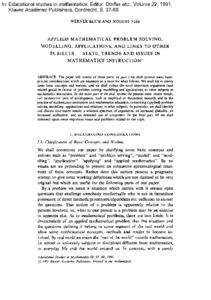| dc.date.accessioned | 2009-06-17T06:55:27Z | |
| dc.date.available | 2009-06-17T06:55:27Z | |
| dc.date.issued | 1991 | |
| dc.identifier.issn | 0013-1954 | |
| dc.identifier.uri | urn:nbn:de:hebis:34-2009061728266 | |
| dc.identifier.uri | http://hdl.handle.net/123456789/2009061728266 | |
| dc.format.extent | 3140471 bytes | |
| dc.format.mimetype | application/pdf | |
| dc.language.iso | ger | |
| dc.rights | Urheberrechtlich geschützt | |
| dc.rights.uri | https://rightsstatements.org/page/InC/1.0/ | |
| dc.subject.ddc | 510 | |
| dc.title | Applied mathematical problem solving, modelling, applications, and links to other subjects | eng |
| dc.type | Aufsatz | |
| dcterms.abstract | The paper will consist of three parts. In part I we shall present some background considerations which are necessary as a basis for what follows. We shall try to clarify some basic concepts and notions, and we shall collect the most important arguments (and related goals) in favour of problem solving, modelling and applications to other subjects in mathematics instruction. In the main part II we shall review the present state, recent trends, and prospective lines of development, both in empirical or theoretical research and in the practice of mathematics instruction and mathematics education, concerning (applied) problem solving, modelling, applications and relations to other subjects. In particular, we shall identify and discuss four major trends: a widened spectrum of arguments, an increased globality, an increased unification, and an extended use of computers. In the final part III we shall comment upon some important issues and problems related to our topic. | eng |
| dcterms.accessRights | open access | |
| dcterms.alternative | state, trends and issues in mathematics instruction | eng |
| dcterms.bibliographicCitation | In: Educational studies in mathematics. - Dortrecht [u.a] : Kluwer, 22.1991, S. 37-68 | |
| dcterms.creator | Blum, Werner | |
| dcterms.creator | Niss, Mogens | |

